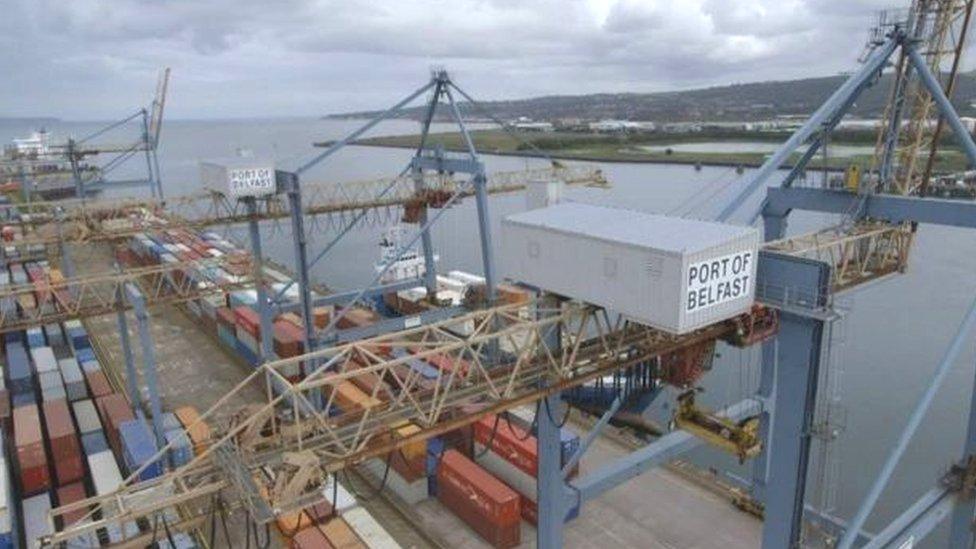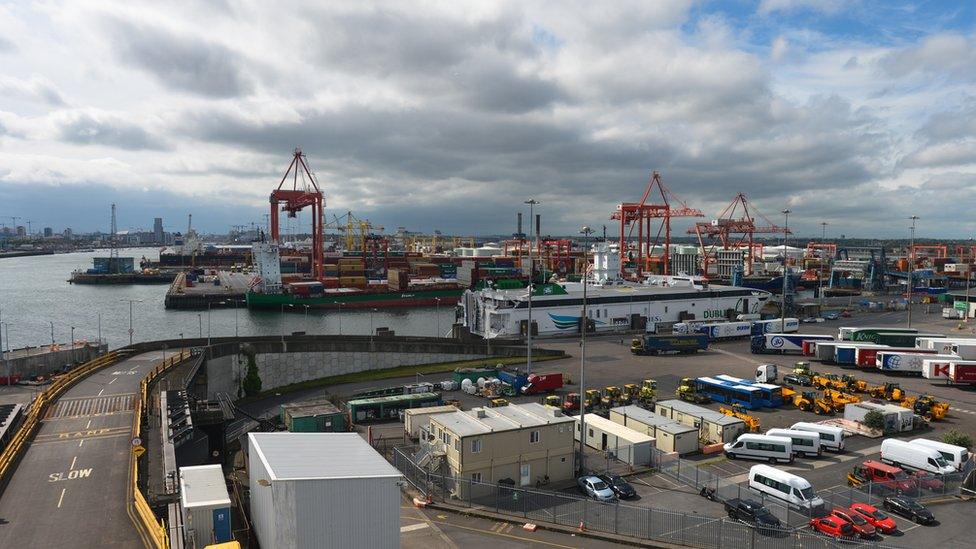Belfast Harbour records busiest year for freight traffic
- Published

Belfast Harbour handled 25.6 million tonnes of freight, up 9% on 2020 and almost 7% more than in 2019
Belfast Harbour had its busiest ever year for freight traffic in 2021, with volumes surpassing pre-Covid levels.
The harbour handled 25.6 million tonnes of freight, up 9% on 2020 and almost 7% more than in 2019.
It said a bounce back in global trade and the impact of improved port infrastructure contributed to the performance.
The impact of Brexit and the Northern Ireland Protocol is also having an impact on trade patterns.
Michael Robinson, Belfast Harbour's port director, said: "Following the UK's exit from the EU, changes in roll-on/roll-off (Ro-Ro) traffic volumes on routes between Ireland and Great Britain have taken place.
"All Northern Ireland ports, including Belfast, have experienced improved trade volumes whilst grace periods continue to apply."
Goods leaving Northern Ireland ports for Great Britain do not face any checks or controls.
However, if Northern Ireland goods are shipped to Great Britain via ports in the Republic of Ireland they do face post-Brexit controls.
That has led to some Northern Ireland hauliers and their customers reducing their use of Dublin Port in favour of Northern Ireland ports.
Analysis published last year by Ireland's Maritime Development Office said it was clear that from early 2021, haulage companies based in Northern Ireland had "transferred some traffic away from Ro-Ro services in the Republic of Ireland in order to avoid the new customs requirements involved between Ireland and UK ports".
There is also some evidence that some Republic of Ireland-based hauliers have been making greater use of Belfast for GB-Ireland imports.

Some Northern Ireland hauliers and their customers have reduced their use of Dublin Port (above)
Ro-Ro freight through Belfast in 2021 reached almost 600,000 units, which was 12% higher than 2020 and 11% higher than 2019.
Container traffic, which is generally non-UK freight, increased by 15% to 132,000 units handled, which was the highest level since 2008.
Bulk freight was up 3% to 9.76 million tonnes, with a number of bulk categories posting their strongest year on record.
This included grains and feedstuffs, which were up 4% to 2.43 million tonnes; aggregates, which were up 6% to 1.86 million tonnes; steel, up by 50% to 244,000 tonnes; and scrap metal, which saw a 13% rise to 412,000 tonnes.
Passenger traffic also showed a recovery as pandemic travel restrictions were eased.
The volume of ferry passengers travelling through the port increased by 69% year-on-year to almost 1.5 million people.
That is just below the pre-Covid level of 1.6 million passengers in 2019.
Mr Robinson said the results showed "a positive trading picture for Belfast Harbour and demonstrate the resilience of the port community as it continues to deliver goods and services across Northern Ireland".
"In spite of the challenges faced since the outbreak of the pandemic, Belfast Harbour has benefitted from an increase in global trade and the resumption of domestic travel," he added.
Related topics
- Published30 June 2021

- Published1 July 2020
